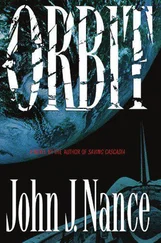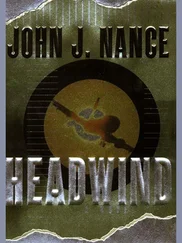Marty whirled around, almost smashing his face into the flight attendant’s.
“Nancy. Get back up to the cockpit and tell the copilot to turn on the overwing lights.
She started to move and he stopped her. “No! Wait! Instead, tell him to tell you where the switch is, and you do it. He can talk your hand onto it. I don’t want him to let go of the yoke. Understood?”
She nodded, terrified and silent, and disappeared up the aisle as he turned back to the window, pressing his nose against the plexiglass, aware that the 1900’s fuselage was vibrating visibly — not exactly rocking, but shaking and shuddering in the high-speed airflow.
And there was something else, and it chilled him as if the abstract had suddenly become reality. There were lights in the cabin of the ruined commuter — and in the cockpit a flashlight beam suddenly stabbed toward him. Marty could see whoever it was turn the beam on his own face, as if the underscore the fact that he wasn’t just dealing with a thing on his right wing.
He could see a cascade of long hair illuminated by the flashlight. The captain was apparently a woman, and somehow that made everything worse.
The white overwing lights on the side of the 757’s fuselage suddenly snapped on, flooding the nightmarish scene on the right wing like a single spotlight on an empty stage. He could see the remaining stream of kerosene leaking away into the night from the hopelessly gouged right main fuel tank, and with sinking heart he saw just how precarious the catastrophic mating of the two aircraft really was. The fuselage was just barely stuck on the Boeing’s wing. It wouldn’t take much abrupt maneuvering to get rid of it.
How the Beech had missed the 757’s right engine was a mystery in itself, but right on top of it — anchored tenuously by the wheel less right main landing gear at the end of a channel of ripped aluminum wing surface — was what? Ten thousand pounds of ruined airplane? Maybe more.
“Jesus Christ!” Marty said under his breath, aware every passenger within view was waiting to read his face when he stood and turned around. He had to look calm and in control, which would be a visceral lie.
Nancy was back, waiting quietly behind him, this time not as close.
How long has it been? Marty wondered. It felt like ten minutes since the collision.
“What do you think, Captain?” Nancy’s soft voice was holding up well, he thought. She had to be at least as terrified as he was, but neither of them could afford to show it.
He glanced at her, the words he had not wanted to verbalize escaping straight from his thoughts.
“I’ve got to find a way to get this bird down without changing the angle of attack.”
“I’m… sorry, I don’t understand that term.”
“The angle of the wing into the wind,” he said, turning back to the window again, no longer holding a tiny, irrational hope that the specter might have disappeared. How the hell can I do this, he thought, his synapses firing on a solution. Maybe if we milk the flaps down as we slow…
The way the ruined commuter was jumping and jerking around, if the airflow canted upwards anymore — hit it from a lower angle — the chances of it pulling loose were obvious. He could see the little Beech’s right wing occasionally flutter into view on the far side of the embedded 1900’s fuselage. That wing was producing lift, which was probably why they hadn’t just rolled over to the right and lost control immediately after impact.
But if it produced too much, it could fly them right off the wing. “Can we bring them in?”
The voice came from someone behind them standing in the aisle. Marty turned to find four ashen faces hovering above Nancy’s shoulder, one of them belonging to another of his flight attendants.
“What?”
“Captain, if we could open the emergency exit door two rows ahead, couldn’t we get those people across the wing and safely in here?”
“No,” he said, backing out of the seat row and preparing to dash forward.
“I think we can do it!” a male voice answered, two more chiming in for clueless support. The mere idea frightened him, and Marty turned to them. “I’ve got to get back to the cockpit, but don’t even think about opening that door. There’s no way.”
“Well, wait a minute!” One of the men said, glancing around as if confirming he had allies. “Suppose we could find a rope? Don’t you have a rope?”
The sight of the captain raising his hand for quiet had the desired effect.
“Hey! The wind over that wing? It’s two hundred and fifty knots … almost three hundred miles per hour. That’s worse than any hurricane! There’s no way to get a rope tied between them and us, and even if we could, there’s no way for anyone to hang on. They might as well be on the moon out there.”
“Well, then, slow us down, Captain,” one of the women said, as if only a moron wouldn’t be able to figure that one out.
“If I do,” Marty added, choosing his words carefully, “I’ll have to pull the nose up, meaning the wing will be at a greater up-angle to the oncoming wind in order to produce more lift, and if that nose-up attitude — what we call angle-of-attack — gets too great, the wind will raise their fuselage from our wing and fling it off. Their left wing is gone. They’ll die if they fall away from us.”
How could the import of his own words chill him so, Marty wondered, but there it was, in a nutshell. He turned and began moving back toward the cockpit as fast as he could without running, trying with only moderate success to suppress the thought of setting a 757 onto a short, slick, snow covered runway at just under three hundred miles per hour.
Seven Months before — January 21 st
Newsroom, The Denver Post
Scott Bogosian had stopped what he was doing, his attention drawn to an array of state-of-the-art flat TV screens hanging across from the City Desk, searching for special report banners or anything that would explain why he had been suddenly attracted. In the middle of a growing blizzard anything could happen in the way of breaking news, although his mental recitation of that grossly overused term made him cringe. Before the end of the Rocky Mountain News Scott had proudly posted a sign over his cubicle that prompted rolled eyes, but he loved it: “When news breaks, we fix it!”
There was nothing on the monitors to explain his sudden shift of attention. Of course, he’d been on alert all afternoon. Too many years of subconscious monitoring, he figured, his ear fine-tuned to police and fire radio channels, and now all of that supplemented by the visual addition of all the local and cable channels with their speakers off.
Something, though, had yanked the chain of his otherwise engaged conscious mind.
He looked around the newsroom, but no one was demonstrating the behavior of a newsroom on the scent of a new story — no one had popped up like a disturbed prairie dog.
There it was again, a short transmission, but coming from a desk to his right, and he realized one of the other long-time reporters — an inveterate pilot — had left his handheld aviation scanner on. That was it! Suddenly it had burst into activity.
Scott moved to the adjacent vacant desk and examined the little radio, reading a combination of aviation-only radio channels. It was jumping from frequency to frequency like any scanner, and once again it snagged an urgent voice.
“Roger… what are… I mean… how can we help you?”
Seconds went by before the reply as Scott wondered what he’d missed, and what phrase had caught his attention. The volume had been so low… how could he have understood anything from the distance of his desk?
Читать дальше












